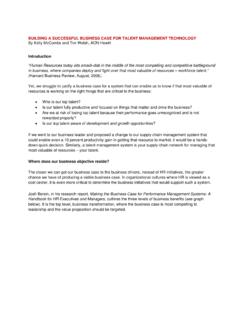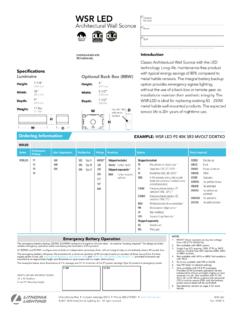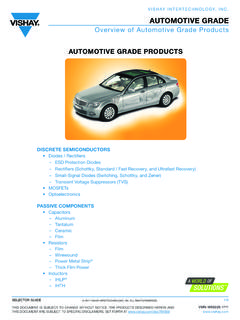Transcription of TRANSFORMATION OF THE HR FUNCTION - IHRIM …
1 TRANSFORMATION OF THE HR FUNCTION By Ashwin Jayaram In the last 18 months, we have seen organizations go through a multitude of changes. We have seen it all scaling down, mergers and acquisitions, growth, regional models to global models, expansions, massive restructuring and reorganizations. Not once, not twice several times over. Sometimes so much so that organizational TRANSFORMATION is more affectionately called organizational churn. The HR FUNCTION has been key to just about every kind of change there is. Most global organizations recognize the value-chain proposition that HR brings to the business. The last decade or so has been crucial in the evolution of HR from a transactional to a strategic partnership focus.
2 However, there is much work to be done. The HR FUNCTION must continue the evolutionary journey, transforming from pure strategic partnership to being a strategic player. An HR FUNCTION that positions itself as a strategic player, , a revenue-generating FUNCTION , whether directly or indirectly by way of productivity increase or talent upgrade, can enable the organization to take leaps in a way that creates an unfair advantage over competitors. Cost-cutting initiatives at organizations to effectively compete in a global market place often result in a new charter for the chief Human Resources officer (CHRO) HR is not exempt. Sometimes, redesign within the HR FUNCTION isn t so much an initiative of how HR provides a more efficient level of service to the business as it is about simply taking cost out of the system.
3 Often, restructure and redesign are two very different activities. Sometimes, a restructure forces a redesign and sometimes, the former is a consequence of the latter. A carefully planned overhaul of the HR FUNCTION is one where restructure and redesign occur as a FUNCTION of each other, , the Yin and the Yang. Most HR professionals have now created a niche market for themselves one in which change management, organizational design and development, and even mergers and acquisition skills are highly sought-out. Organizations, big, small, private and public want strategic thinkers, people who understand change, have an acute sense of business acumen and global exposure. Job descriptions, conversations, and interviews can be likened to a buzz-word fish market strategic ideas and words bounce of the walls, and discussions are focused on how important a strategic HR FUNCTION is, and the ideal candidate would be one who doesn t necessarily do HR for HR but instead HR for business.
4 While the interest and gravity of HR evolution is critical and great news for businesses, the pressing question remains: Do we have the HR infrastructure to build upon and sustain successful change? This question poses four significant challenges: Organizations implement restructuring and design changes in a slow-fast-slow pattern Just do it ! According to recent CLC research, only 60 percent of organizations are able to meet performance targets as a FUNCTION of major organizational redesign efforts. A majority of redesign efforts aim to meet cost-cutting targets but not employee performance targets. The crux of successful organizational restructuring is in the implementation and management of change. Typically, organizations tend to spend months developing a plan, and going through process mapping, alignment and design.
5 During this time, lack of transparent and lucid communication plans result in prolonged periods of rumors and biased grapevine messages. All of sudden, a roll=out date is announced and soon after, the switch is flipped. While much time has been spent on organizational design and people movements, the actual change lacks in adequate communication and clarity. Generic plans are announced via e-mail and town hall meetings while employees find themselves either out of jobs, in new roles, or with completely new leadership. The turnaround time between announcement and implementation is lightning-quick. It then takes employees months of slow and arduous work to adjust to role-specific processes and comprehend changes in the business landscape and change in leadership and line of sight to customers.
6 A recent case in point is a Fortune 500 company with over 80,000 employees and US$50 billion in annual revenue went through a major re-haul of the global HR FUNCTION . The planning, design, and roll-out all happened within a span of 60 days. Over 90 percent of the HR organization and 100 percent of the business found out about the change either through e-mail or a town hall meeting on the day of roll-out. Neither HR nor the business was ready for massive changes in terms of the structure and FUNCTION of HR. Top HR talent left the organization to pursue other opportunities. Human Resources professionals were not well-equipped with tools to manage the change within the business. The HR leadership team then had to spend the next six months rebuilding credibility and trust in the organization, only to follow up with yet another restructure.
7 Lesson Learned: Organizations must focus on a change and communication plan well in advance. The involvement of experienced change agents that can design, plan, and effectively enable organizations to build a solid infrastructure and support system, as well as successfully get employees to embrace change is essential. Human Resources functions are not nearly as good at redesigning themselves as they at redesigning other functions Charity starts at home. In an effort for HR to be more strategic and align with TRANSFORMATION of businesses, HR functions at many organizations embark on a journey to redesign themselves. However, not only do HR professionals struggle with some of the same change issues that other employees in the business face, but HR professionals have an additional task of managing the impact an HR reorganization and redesign has on the business.
8 Change management, in such a case, is a two-way street for HR. Human Resources is a delicate organization and way too many HR professionals complain about not receiving the level of support from HR for HR. Ideally, the HR FUNCTION is looked upon as the backbone of an organization s employee morale and productivity. How, then, can an HR FUNCTION that does not have high levels of engagement be able to efficiently provide support to the rest of the organization? Lesson Learned: It is critical for HR leaders to involve the rest of the HR organization from the initial stages of massive redesign. Key executives in the business must be privy to changes within HR. Robust change management plans for HR and appropriate toolkits that HR professionals can leverage to manage the changes in HR support to businesses are a must.
9 Communication can make or break the HR FUNCTION . Strategic HR functions need a strategic talent upgrade You can t make bricks without straw. Organizations that redesign the HR operational model do so in a number of ways. Automation, investments in HR technology, self-service models, rules of engagement, infusion of lean principles are only some of many ways. A reshuffle of organizational charts does not make for a well-executed HR TRANSFORMATION . Progressive CHROs also begin making investments in HR talent. Chief HR officers hire external HR professionals who have been through similar changes and understand what it takes to build a strategic HR FUNCTION . A talent upgrade cannot stop at hiring a handful of seasoned strategic HR professionals.
10 A thorough talent review of the HR FUNCTION is necessary to indentify evolutionary skill and competency gaps. Human Resources competencies and performance management systems must be revisited and updated to reflect the future state of the FUNCTION . For a successful and, more importantly, sustainable TRANSFORMATION of the HR FUNCTION , the CHRO must put measures in place to bridge identified gaps in the HR community. Lesson Learned: Careful attention must be paid to source, select, and hire HR professionals during a time of HR TRANSFORMATION . Human Resources leaders should not hire someone simply based on the experience required to support line managers or business leaders. Instead, they should move away from pure experiential and traditional HR competencies.





